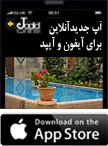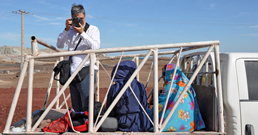11.2.2013
Riccardo Zipoli
In January 1975, having left Tehran and my university lessons for a short vacation, I set off on my first journey in the Persian Gulf. My destination was the island of Hormoz, where I wanted to see the colored mountains, which some friends had described to me. I arrived around noon and rented a scooter to tour round the island. This trip was to deeply influence my subsequent experience of Iran.
I discovered a set of very suggestive forms and colors: crusts of brilliant white salt, iron-rich red soil, dark volcanic rocks, springs and ponds with transparent water colored by minerals, some bushes, isolated trees, jagged hills, at times rising up sharply, and an intense blue sky. My initial impression was that I had been plunged into a world of unreal landscapes. Now, so many years later, I understand the reason for this better. Those landscapes rich in forms and colors were as if stripped of that third dimension which usually characterizes our everyday world. Perhaps it was the strong, very clear light, the incredibly bright hues, the limpidness and almost complete absence of shadows, the deep silence and the total solitude, but those scenes seemed to be contrived. They appeared to have been portrayed on a canvas, but with no perspective, in a style reminiscent of miniature painting. Since then that type of landscape has stuck in my mind as a kind of ideal model that I have always sought to find again and to photograph on my many trips to Iran. At that time, however, photography had not yet become a predominant part of my education, a part that eventually coincided with my way of observing the world. So I only took a few shots and was more interested in admiring and trying to understand rather than record my feelings for aesthetic purposes. I am particularly fond of some of those photographs (shot in Bandar-e ‘Abbâs and Hormoz), which are now included in this exhibition.
I returned to the area twice: in 1980 (the photographs of the island of Qeshm and some photographs of Bandar-e ‘Abbâs are from that time) and 1995 (when I visited and photographed the area of Châh-Bahâr). In those circumstances, too, I only made brief trips, characterized more by the pleasure of the experience than by my efforts to take photographs. Inspired by the idea of the current exhibition, I searched my archives of these two last journeys for some images to set beside those of Hormoz. The aim was to construct a small collection that, apart from being my own personal travelogue of those three distant journeys, would also convey an idea of the places in a blend of memory and documentation. At that time I was still working with slides which, because of the many years that have elapsed, now inevitably show signs of ageing (especially the grain and the colors). But overall the material is in a satisfactory condition. They are photographs of a past that I have come to reconsider today and, as often happens in such situations, I find some things with which I still identify and others that now feel more remote. Almost half the photos are of people: women with brightly colored clothes and the famous ‘masks’ walking (but never on the seafront) with a jar or can on their heads; more soberly dressed fishermen who idly and melancholically wander along the seashore looking at their own boats or directly at the camera; children and adolescents walking, playing, working, thinking, or observing you, all on the seafront. The remaining images are of landscapes, mainly from the interior of Hormoz, but there are also some seascapes (two at sunset) near the island of Qeshm. Some typical vessels also feature: they have been shot both in deep water or stranded at low tide, while a couple of close-ups satisfy my innate tendency to abstract representation. Photographs of architecture portray two types of buildings found in the area – Portuguese castles and mosques.
The overall picture is of an area outside the current conflicts – a beautiful, fascinating and peaceful region. Moreover, in this region Iranians and Arabs, Shi'ites and Sunnis live together in keeping with the cosmopolitan spirit of the past, thus offering a great opportunity for fraternity and progress. The hope is that with the help of science, culture and art the day will soon come when local natural resources will be secured from any threat, and military helicopters and aircraft carriers will leave the sea forever to dolphins and seagulls.
Riccardo Zipoli teaches Persian language and literature at the University of Venice.
A Gulf, a Strait and a Sea (1975-1995) is shown until 17th April 2013 at Paradise Art Centre, Hormoz Island.
 Like us on Facebook
Like us on Facebook
Share this story


